Bobbi Macdonald is the founder and served as the first board president of City Neighbors Charter School in Baltimore, MD. She was selected by the Annie E. Casey Foundation as one of 16 leaders from across the country for the 2013-2014 Children and Family Fellowship.
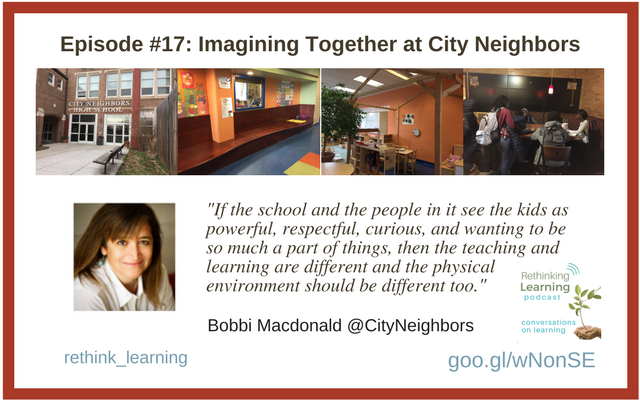
Podcast: Play in new window | Download
I met Bobbi at Educon in Philadelphia last year when she presented with Education Reimagined and shared her story about City Neighbors. She invited me to visit her school so I did with Lori Roe in February. First thing I noticed was Bobbi’s passion and purpose was about creating an environment for kids. It was an amazing visit where I could see engagement and hear how teachers and kids were motivated to learn. I really enjoyed our conversation and added excerpts from the podcast below.
Can you share your background, your own story and why you are so passionate about transforming learning?
I grew up on the southside of Chicago and my family to the south suburbs in the 70s. I come from a long line of educators and salesmen. The school I moved away from in Chicago was a strict instructional experience. I remember sitting in a circle reading Sally, Dick and Jane books and each person would get to read one word. I wished I could read “Sally” or “Jane” but I always got “and” or “the.” Then we moved to the suburbs and I went to Willows School. There were kids in the hallway laying on their tummies with their math books open and other kids practicing a show. I grabbed my mom’s hand and said those guys are going to get in so much trouble. She said, “it’s a little different here, Bobbi.” That made such an impression on me. When I grew up, I became a kindergarten teacher, early childhood educator, and worked in child development labs. I loved that research on how children learn and how you create a great environment. That led to different positions and eventually moved to Maryland for graduate school.
How did you come up with the City Neighbors Charter School?
 My husband and I have four kids. When the youngest was ready to start kindergarten, I went to visit the school near my house and couldn’t believe how so restrictive the teaching and learning was. It was filled with good people but the design was wrong. That was the day Maryland passed the charter school law. So we had the opportunity to imagine a great public charter school. The idea for City Neighbors was to be the best school we could imagine. We based the school in seeing children as powerful, and teachers a powerful. We took a stand on project-based learning, arts integration, Reggio Emilia inspired, and a family-teacher co-op. The work of the school is to have the people in the building imagining together. Once I realized I didn’t have to be exactly right, I felt like I had the courage to give it a try and create an environment where the imagining becomes the culture.
My husband and I have four kids. When the youngest was ready to start kindergarten, I went to visit the school near my house and couldn’t believe how so restrictive the teaching and learning was. It was filled with good people but the design was wrong. That was the day Maryland passed the charter school law. So we had the opportunity to imagine a great public charter school. The idea for City Neighbors was to be the best school we could imagine. We based the school in seeing children as powerful, and teachers a powerful. We took a stand on project-based learning, arts integration, Reggio Emilia inspired, and a family-teacher co-op. The work of the school is to have the people in the building imagining together. Once I realized I didn’t have to be exactly right, I felt like I had the courage to give it a try and create an environment where the imagining becomes the culture.
What is the philosophy behind City Neighbors and how Reggio Emilia was an integral part of the design?
As an early childhood educator, I learned about Reggio Emilia at the University of Illinois and then in graduate school at the University of Maryland. Reggio Emilia is this amazing program out of Italy that honors the teacher as researcher, the physical environment as being important, and the parent as the first teacher. That just sounded like good education to me, and it made a lot of sense to push Reggio up to the higher grades. The interesting part is that City Neighbors is really a cooperative. It is owned by so many people. That’s the design and the secret sauce of City Neighbors. The teachers and educators are around tables and in groups working collaboratively, arguing, discussing, imagining, and creating. That is what makes City Neighbors come alive. That ethos gets transferred to the kids, and they are encouraged to have ownership over their own learning. After we opened the first school in 2005, the waitlist grew and grew. At first, we thought about expanding the building. We ended opening two more campuses: City Neighbors Hamilton (est. 2009, K – 8) and City Neighbors High School (est. 2010) so now there are 3 schools serving over 850 in Kindergarten through 12th grade.
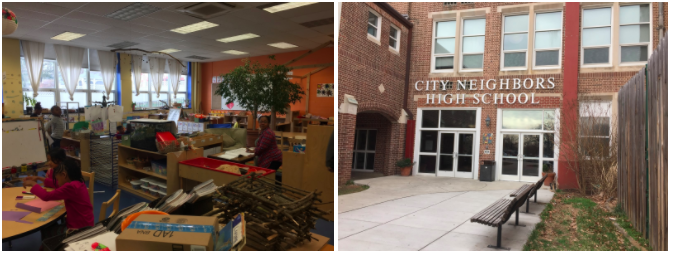
You mentioned that City Neighbors cares about the learning environment. Why did you transform and redesign the learning spaces?
If the school and the people in it see the kids as powerful, respectful, curious, and wanting to be so much a part of things, then the teaching and learning are different and the physical environment should be different too. The industrial model with the chairs and desks lined up ready to receive from the all-knowing teacher is an old-fashioned model now. To us, it makes a lot of sense that the environment is designed to build independence, collaboration, and creativity. So we are constantly pushing ourselves to let go of what we thought it always had to be. We go to creative extremes because every color and texture matters. Are there loving, warm places to be together? What types of conversations are going to happen in these hallways? We think about these questions and more from the students’ perspectives. We believe the physical environment is part of the relationships we establish as a community. Trust, transparency, the display of student work, the documentation of the thinking happening in the building – all of these are part of creating a learning environment. Always our teachers are improving, creating, trying new ideas. How joyful to be on a quest together to create the best schools we can imagine!
I know when I visited City Neighbors, I felt it was so warm and welcoming. How are the kids using the different learning spaces around the school?
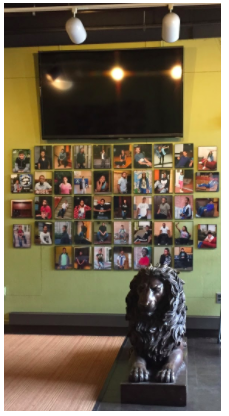 In the high school lobby, the freshman class school pictures are unveiled each year in a ceremony. The cool thing about that tradition is it symbolically it conveys to our students how much we honor and value their uniqueness and that City Neighbors High School is where they belong. The students are not standing in front of the same background in the pictures. A photographer works with every single freshman to make sure each picture is unique.
In the high school lobby, the freshman class school pictures are unveiled each year in a ceremony. The cool thing about that tradition is it symbolically it conveys to our students how much we honor and value their uniqueness and that City Neighbors High School is where they belong. The students are not standing in front of the same background in the pictures. A photographer works with every single freshman to make sure each picture is unique.
My brother, Michael, helped design restaurants in Chicago so we flew him out here to work with the kids to design the cafeteria. He took them through a process to create a wonderful space.
There are booths, low and high seating, couches, outdoor seating, a bike on the wall, a stage, a piano, and cool cafe lighting, Without any adult supervision, the kids have had dance-off competitions there at lunchtime. It’s really space where you see kids being kids enjoying each others’ company while eating lunch. We need to rethink how schools look and feel if we are asking kids to become citizens that can operate with a level of independence and have a sense of community and commitment to each other, then we need to start practicing starting at kindergarten. The physical environment helps us do that.
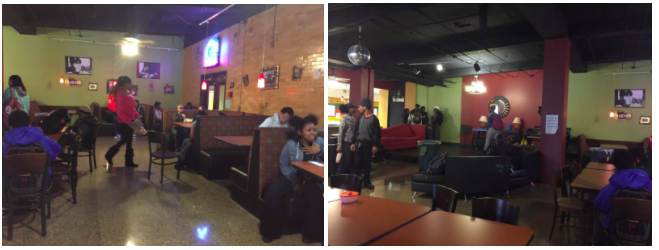
There were no lockers in the hall. The colors were warm. There were window seats outside every classroom. How do these and other spaces help to know and inspire your kids?
We had the opportunity to renovate this 1931 school building. We wanted to honor the beauty of that building which was in terrible shape when we got it. We also wanted to bring it forward so it was the design we imagine. We knocked out as many walls as we could and put in huge windows from the classrooms to the halls. The idea was to have the hallways be extensions of the classroom. The teacher could then do passive supervision by being in the classroom and glancing through the window to see kids working in the hall. We built in benches under the windows outside the classroom so the kids had a place to sit in the halls. We carpeted the hallways.

We put the lockers into advisories. Our design question “What would it take for every kid to be known and inspired?” led us to create a new kind of home within the school we call pod. For 90 minutes a day, days a week, the whole entire high school is in a pod. The pod has a dedicated living room, kitchen area, individual workspaces, and student lockers.
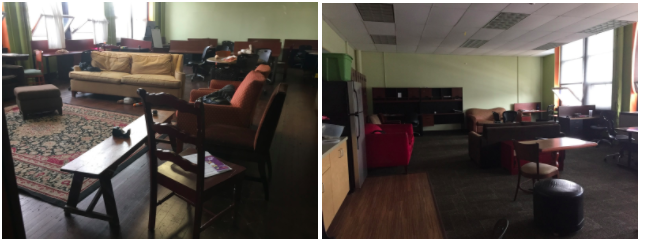
I saw the students work in the hallways. Can you expand on how your teachers and kids use the hallways for evidence of learning?
We put up this material called homasote on the walls in the hallways. That makes it so easy to hang student work on all the walls in the halls. When you have a big wall, you can show what kids are thinking and the process of a project as it unfolds. That is called documentation and making learning visible as they say in Project Zero. Our teachers work hard as we do that and showing what we value. It’s treating the student work as the honored data it really is and to show what’s happening in the building. We want students working in the hallways, it is one of the ways we measure school climate, the level of independence our students display. Freedom, liberty, and responsible citizenship are the values that must be practiced.
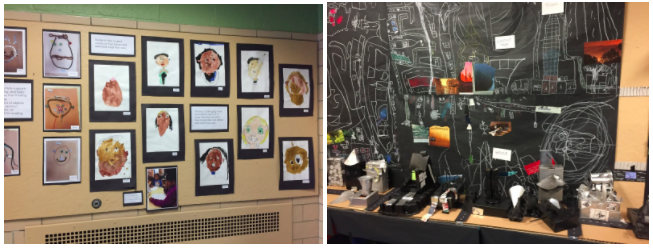
You mention the building. It was fun to explore all the spaces including the FabLab. Can you share what happens there?
On our campus is a 1950’s rec building that we restored. In the basement, there are two lanes of duckpin bowling – a Baltimore tradition. Rather than take out the lanes, we took out the wall hiding the inner workings of the pin return – and we decided to create a FabLab Makerspace in the basement to bring the beautiful past traditions into the present and create a wonderful future for students. Kids learn how to do digital fabrication, how to use 3D printing and design, and work the laser engraver. There is woodworking, electronics, sewing. We see our students as inventors, thinkers, creators. The Fab Lab Makerspace is a place to make things with your hands, create an idea, design something, and produce it.
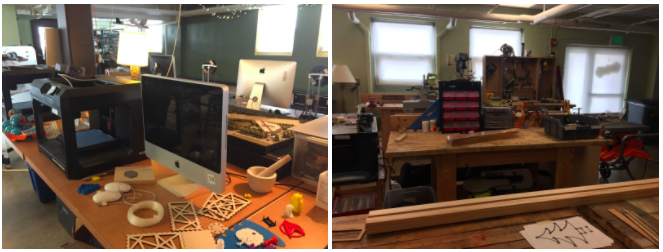
One of the reasons I wanted to visit your school was because you are focused on project-based learning. How do your kids have a voice and choice in learning?
We really try to show that across K-12 that work has a purpose and meaning. Most worksheets don’t have a purpose except repetition and practice. We try to do authentic work. We believe that can start as soon as you enter school in kindergarten. It actually goes through 12th-grade work and into our lives. We all want to do meaningful work that makes a difference. The projects we do usually have an essential question driving them. It’s amazing if you get a 3rd-grade class taking on a question like “is peace possible?” They spend weeks trying to get to the bottom of that. These are the kind of citizens we want. People who try to figure it out, discover who they need to talk to, and how they show how they figured it out. They also determine what they need to read and how to demonstrate evidence of what they learned. They may also ask “How do we communicate with others what we think if it is possible or not?” That’s the kind of teaching and learning we’re after.

What are your hopes and dreams for the future of City Neighbors?
I hope that City Neighbors continues on the path of learning, of being a strong voice for progressive education for all students. Our teachers, and staff, our wonderful school leaders, and Mike Chalupa, our Academic Director are on a blazing path that is focused on a creative process for building culture, creating a loving environment, and making sure every student is KNOWN, LOVED, AND INSPIRED.
*****
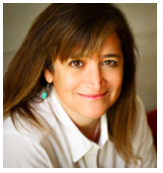 Bobbi Macdonald is the founder and served as the first board president of City Neighbors Charter School. She was selected by the Annie E. Casey Foundation as one of 16 leaders from across the country for the 2013-2014 Children and Family Fellowship. Previously Bobbi taught early childhood education and kindergarten in two University child development laboratory schools and served as literacy trainer for Head Start and the Children’s Literacy Initiative. Bobbi received her Bachelor’s Degree from the University of Illinois in Human Development and Family Ecology and holds a Master’s Degree from the University of Maryland, College Park, in Curriculum and Instruction.
Bobbi Macdonald is the founder and served as the first board president of City Neighbors Charter School. She was selected by the Annie E. Casey Foundation as one of 16 leaders from across the country for the 2013-2014 Children and Family Fellowship. Previously Bobbi taught early childhood education and kindergarten in two University child development laboratory schools and served as literacy trainer for Head Start and the Children’s Literacy Initiative. Bobbi received her Bachelor’s Degree from the University of Illinois in Human Development and Family Ecology and holds a Master’s Degree from the University of Maryland, College Park, in Curriculum and Instruction.
Beginning in the summer of 2003 as a grassroots movement among a group of city neighbors, 17 families worked together and submitted the charter for an arts-integrated, project-based, Reggio Emilia-inspired parent-school cooperative in Baltimore. Today, the City Neighbors network of three schools, K-12, serves more than 850 children.
Bobbi’s contact information
- Email: bmacdonald@cityneighbors.org
- Twitter: @cityneighbors
- Facebook: https://www.facebook.com/cityneighborsfoundation/
City Neighbors in the news:
- High School Should be More like Kindergarten: Hechinger Report http://hechingerreport.org/high-school-like-preschool/
- City Neighbors School: Working at the Edge for Reimagined Education http://workingattheedge.org/wp-content/uploads/2016/04/PP_City.pdf
Interested in checking out more of the Rethinking Learning podcasts and reflections, click on the podcast tab at the top, the logo below, or go to https://barbarabray.net/podcasts/
For more information about Barbara’s book, Define Your WHY, go to this page or click on the image of the book for resources, questions, and links.






